How to choose a screen for a projector
Projectors not so long ago broke into the usual way of life of people, now it’s just a “home appliance” for entertainment or a business tool. In some cases, for displaying content, a screen for a multimedia projector is needed, and the usual cut of fabric is indispensable. The choice of the screen for the projector becomes difficult, one has only to get acquainted with the proposed range. Variants of mass, as well as factors determining the appropriate type. In practice, everything is quite simple if the user understands what exactly he wants to receive as a result.
Content
White matte screen
Standard, simple and popular white matte screen - this is what you should buy if you do not want to understand all the intricacies of materials or surfaces. High-quality canvas can significantly improve the image, but, according to experts, this does not apply to budget versions of projectors.
Devices of lower or medium price categories can design a video well on any white, matte and flat surface. But connoisseurs of high-quality cinema are unlikely to go to such “handicraft measures” as painting the wall white. Smooth surface - This is a key factor in the screen, and the higher the resolution of the image, the more seriously you need to approach this issue. The qualitative image, the dynamic scenes in the cinema are “sensitive” to any defects, in the presence of which the objects will inevitably “float”.
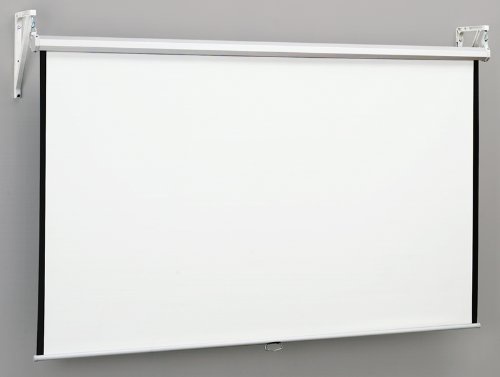
Good to know! A white matte screen is considered a basic or standard solution, but the image contrast will be reduced by background light. It can be compensated either by a good darkening of the room, or by the high power of the projector lamps.
By the way, pay attention to black frames around the canvas - this is not a design step at all. The projected content does not always fit well in size, distortion may appear at the edges.The frame perfectly masks all defects, and also serves as a kind of contrast - the image is perceived brighter against the black color of the border.
We can sum up a little: the better the projected video, the higher the screen requirement. If the issue of economy is acute, the choice can be stopped on the most budget options, for example on products of the company ScreenMedia - they are famous for affordable prices and it is not the first year that they are among the best manufacturers.
Gray screen
The gray screen is more capable absorb background light, unlike standard white. Excessive light always reduces the contrast, this is expressed in faded colors, especially in less deep black. For example, a similar problem is present in LED TVs, when black areas are rather dark gray.
The gray canvas somewhat enhances the contrast, which gives a better and deeper color gamut. But in cases where there is no background light, the gray screen will make the image too dark. Therefore, this option should be abandoned if you use the projector at home, and the windows are securely curtained with blackout roller blinds.
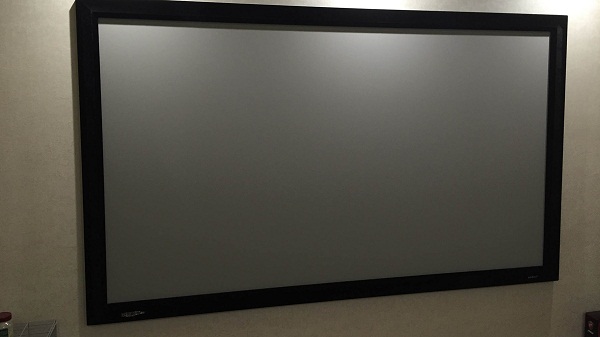
Conclusion: the gray screen is the way out for daytime video views at home, when there is no possibility to provide full blackout, but the sun's rays can be covered with simple curtains. The use of such screens is not justified in a dark room, and in bright daylight it is completely useless.
High Gain Screens
So called canvas with a glossy finish. Light is reflected at an angle, and not distributed evenly, like a matte finish. Such types are much more expensive than ordinary ones; their optimal use is at home to watch movies.
Feature is contrast ratio: here it is definitely higher, black is “deeper”, colors are richer. Increasing the quality slightly reduces the viewing angle. Viewing from the side will not be so comfortable, because when choosing this type, you need to take into account that users should be in the center.
The potential minus of angular reflection of light will be the probability of the appearance of lights or "light spot"Able to completely darken the pleasure of viewing. The user will have to try to adjust the screen relative to the direction of the light so that the reflections are reflected not to the viewer, but to the wall.
Good to know! To prevent light spots from becoming a problem when viewing, you can move the projector away from the canvas.
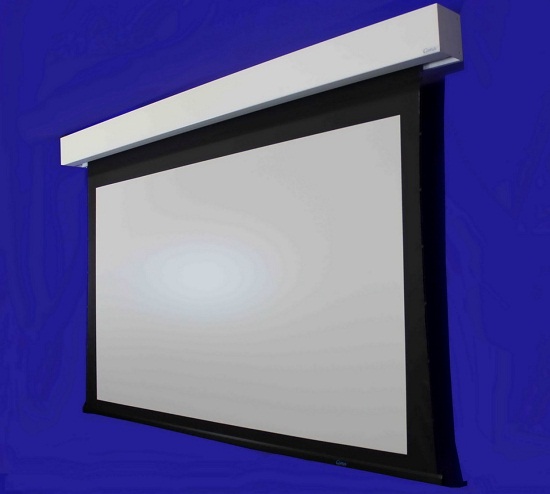
Screen wall Stewart Cima 00932-1092H
There are other variations, such as gray screen with glossyor rather, with additional coverage. Such models are produced by well-known company Stewart. It should be noted that the canvas with an increased gain (higher than unity) is not used in tandem with ultrashort-focus projectors. A close device will transmit too much light and reflections are not excluded. Conclusion: choose this type of screen if your goal is a cozy home viewing of your favorite videos with family or friends.
Projection films
Projection films are not a screen, they are a new step into the future. Moreover, this future is not so much a “domestic plan” as for the business sphere. Films are divided by the percentage of light transmission, can be dark or completely transparent. The canvas is glued onto a plane, for example, onto glass or onto a wall, as a result we get a real analogue of a hologram. And no matter which side to view the video.
Reflecting screens today are no longer uncommon when the projector is installed not by the viewer, but behind the canvas. This type provides more contrast picture due to the fact that all reflections are absorbed and scattered. But if the screens are usually still white, then the transparent or translucent film looks modern and technologically. It is quite curious to use it for promotional purposes - at exhibitions or presentations.
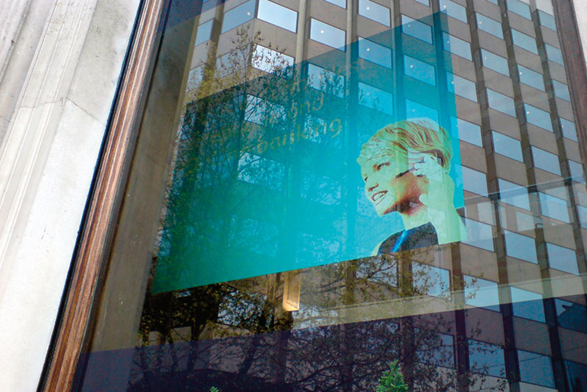
Interesting fact! Do not worry about the fact that the image will be a mirror image, most projectors have a special setting for projection screens.
Conclusion: if you need to impress the audience, projection films are your choice. For those who like unusual high-tech things, there is an opportunity to install glass in the middle of the room.
Alternatives
Speaking of good canvas, you can make a small digression to figure out whether you really can not do with improvised means. This question naturally arises for everyone who wants to save.
In addition to the perfectly flat surface of the screen, it has an excellent property to diffuse light. Cut-off white cotton will pass light through itself, which will reduce the contrast to a minimum, and several of its layers will inevitably create folds, and the watchability will disappear.
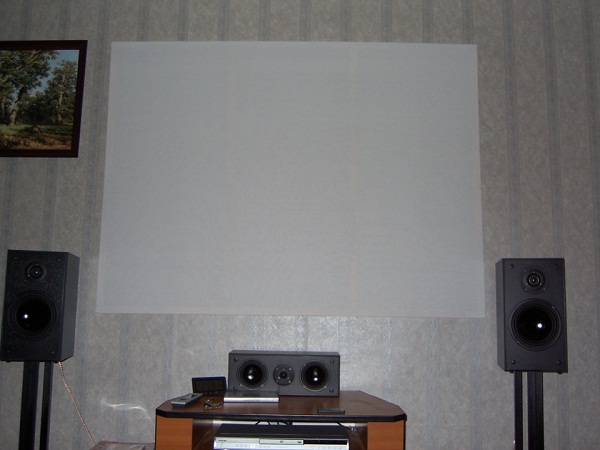
Cotton screen
Wall painting - a popular joke, albeit with some truth. Modern paint and varnish products are rich in all shades of matte white, but now you have to level the surface for a long time. Knowing the subtleties of the finishing craft, one can imagine what labor costs will have to be invested, not to mention the special coating.
The second most popular hand-made attempt black screen for the projector do it yourself. The video demonstrates its exceptional advantages, but practice shows that it is not very expensive, but too difficult. If finding a black base is not a problem, then finding a suitable matte film is quite problematic.
Type of construction and purpose
How to choose a screen for the projector on the type of canvas is already clear, now you can go to the review of design features. Conventionally, there are two large categories:
- stationary;
- mobile
The first type is a solution for a home theater or conference room, when the canvas either folds into a tube or is pulled over a frame. The advantages and disadvantages speak for themselves: the user does not need time to install, assemble or disassemble the structure, the screen is always ready for use, but takes up space.In principle, the television panel also occupies a certain area of the wall, so that it is quite possible to put up with it.
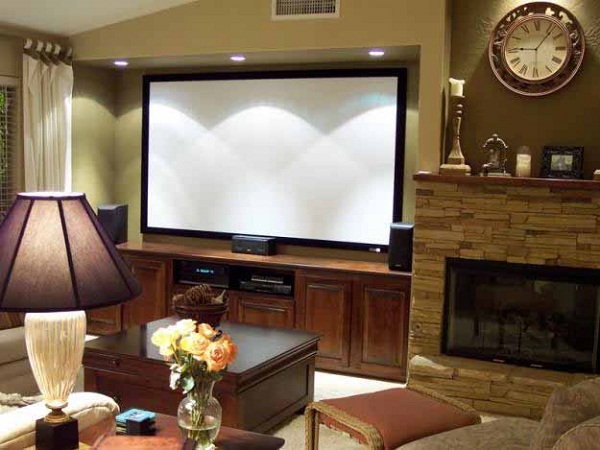
Mobile screens for video projectors are designed for on-site presentations, training seminars and similar events. It is not excluded the use for the home, for example, when the user often leaves the country, or there is no possibility to allocate part of the wall.
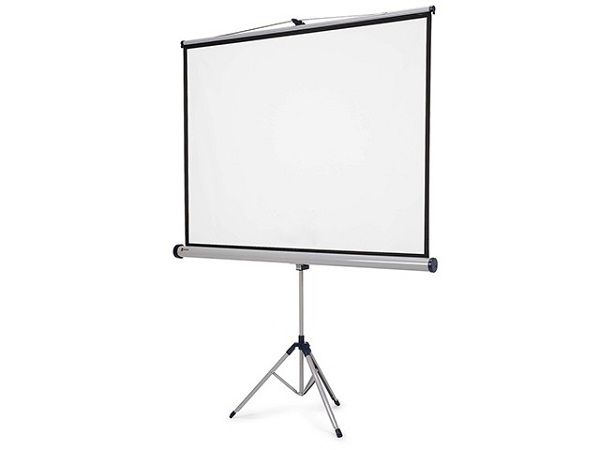
Types of fixed screens
Stationary roll screens are made on the principle of roller blinds: the canvas is wound on a pipe and turns around when necessary. When folded, the structure is protected by a housing that is attached to any reliable plane: wall or ceiling. If necessary, the canvas can block a window opening, a board for a marker, a map. pay attention to models with black backing - it will help to block the light when the screen overlaps the window, from there comes a lot of light.
An interesting solution is when the whole structure is mounted in a stretch or suspended ceiling such as Armstrong, or in a plasterboard box. The screen and the mechanism are completely invisible and do not require space - a fairly flexible solution.
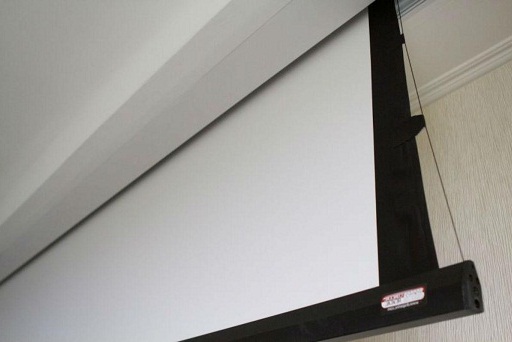
Roll screen installation in the box
Manual control - this is a budget option, the user independently collapses or expands the canvas. Not very convenient, but economical and simple. For lovers of automation and modern technology, developers have equipped the mechanism with an electric drive; here the control is carried out using remote control, but more modern solutions are available: output of a separate button, connection to the Smart Home system or similar.
Good to know! Electric drive is necessary if the screen is located far, high or has an impressive size. True, at home such models are used extremely rarely.
The problem with roll-up screens is that the design is not capable of providing a perfectly flat and smooth surface of the canvas. The solution will be the type of construction with a tension system, they look solid and lack a typical drawback. It is worth noting that their price will be higher.
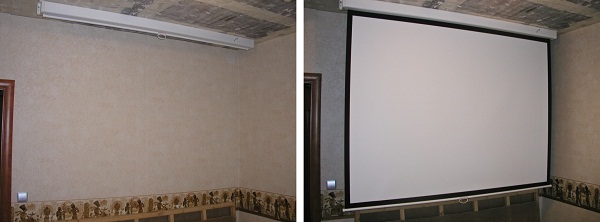
Rolling screen with tensioning system
Projector Tensioning Screens also belong to the stationary type, the canvas is attached to the frame on the rivets or eyelets. Tight stretch provides a perfectly flat surface, so necessary for a great image. The only task for the user is to find a permanent place.
Types of mobile screens
The second option is mobile or mobile projection screens. Usually they are used for business or retreats. This type includes three types: on a tripod, floor-standing or on legs. The design "on a tripod" provides for a tripod stand and tube for storing and transporting the canvas. Practice shows that this is available until the width of the web reaches 2.5 m, after which the transportation becomes difficult.
The screen on the frame or legs is more stable and suitable for wide canvases over 3 m. Assembling and disassembling the whole structure will not take more than 10 - 15 minutes, and transportation is not an example easier: all parts easily fit in a small case.
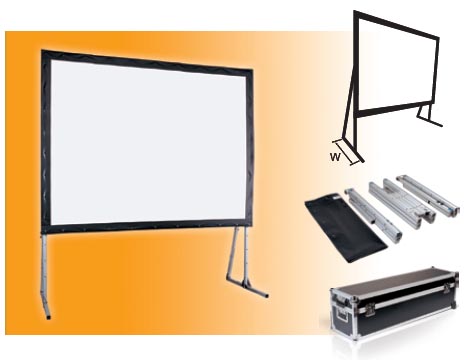
Outdoor version transported in a tube, which in the process of use is the basis of the design. The canvas extends upward and is well held by a special fastener system. Interestingly, here the manufacturers took care of the users seriously: it’s inconvenient to watch the video near the floor, because the lower part of the screen is a black field, and the “working” part for viewing is located in the upper half. A suitable model of this type can be found in the range of Project, Classic Solution or Draper.
There are also desktop variations of such screens, whose design is characterized by the presence of special fasteners to the plane of the table.
A bit about the size and format
What should be the size of the screen - depends on the purpose of its use. Among the various multimedia formats The most popular is 16: 9. It is in it that most of the films are recorded, and if film reproduction is the main purpose of the canvas, then its positioning should be appropriate. Incorrect screen size will lead to the appearance of black bars on top, bottom or side, for some it is trifles, but there are users who do not like it.
For outputting texts or documents more suitable vertical type 4: 3Also, a similar option is optimal for browsing the web. If you play content onto a canvas of an inappropriate size, for example, 16: 9 video on a 4: 3 screen, the picture is either reduced or cropped at the edges. Compromise - roll screens that can be deployed to the required level or multi-format VIP-class.
Note! Choosing the screen size of the diagonal, you need to pay attention to its shape.Two 16: 9 and 4: 3 canvases can have the same value, but in the first case it is oriented horizontally, and in the second - vertically.
So, to choose a suitable screen, you need a bit: decide on the purpose of its use, place, size and format of the content. Consider the degree of exposure to background light, and the possibility of its blocking. After that, there will be only one criterion - financial, but here everyone chooses at their discretion.

/rating_off.png)











